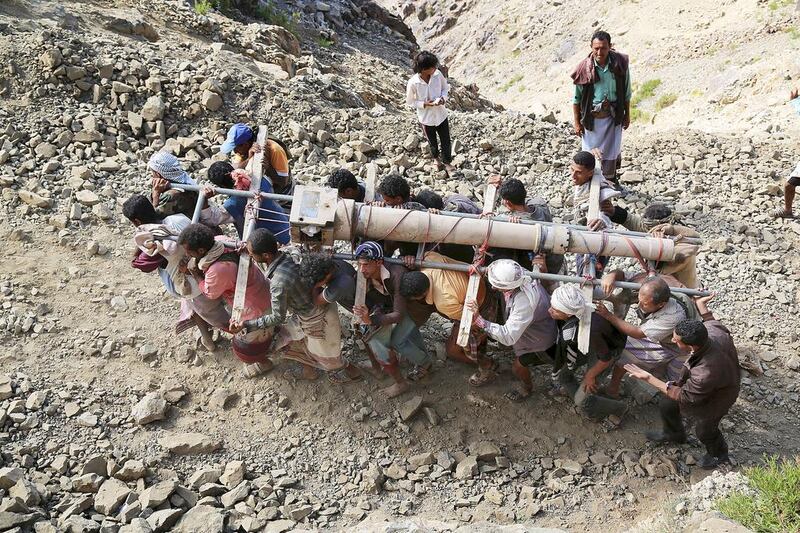ADEN // Yemen’s pro-government forces moved closer to the capital Sanaa on Sunday, while Saudi Arabia shot down a ballistic missile fired from across the border by Houthi rebels.
The resistance fighters and troops fighting in Sanaa province took control of more areas in Nihm district, taking them to within 30 kilometres of the capital, said Mohammed Al Gadasi, a journalist based in neighbouring Marib province, citing military sources.
He said they were now preparing to advance into Bani Hoshaish district, which borders the capital city.
Pro-government forces entered Nihm district from Marib on December 19. Al Gadasi said that as they made their latest gains, the Houthis began firing Katyusha rockets at Marib city, the provincial capital that was liberated from the rebels along with most of the province in October.
“Yesterday, the Houthis rebels targeted the Republican Palace in Marib and four soldiers were killed, while five others injured. Rockets hit other areas of the city but there are no casualty figures yet,” he said.
The pro-government forces are supported by a multinational military coalition led by Saudi Arabia that is seeking to restore the internationally recognised government of president Abdrabu Mansur Hadi, currently based in Aden, to power in Sanaa.
The coalition said on Sunday that Saudi air defences had intercepted “a Scud missile fired from Sanaa in Yemen towards the city of Najran” late on Saturday.
Coalition jets “immediately destroyed the missile launch pad after identifying its location in Yemen,” the coalition said in a statement published by Saudi Arabia’s official SPA news agency.
The Houthis, who are backed by Iran, said they fired another ballistic missile on the Saudi city of Najran on Sunday, but Riyadh has not confirmed this attack.
They also claimed to have caused “losses in life and equipment” in rockets attacks on Najran and Jizan, another southern Saudi city, on Saturday.
The rebels have intensified their rocket attacks across the Saudi border during the past week, prompting the coalition to threaten severe reprisals. Saudi Arabia has deployed Patriot missile batteries to counter the missile attacks.
The rebels also lost ground in Al Bayda on Sunday, a northern province they largely control, in an offensive launched by resistance fighters a day earlier.
The resistance seized the centre of Thi Naem district, killing six Houthis, but has not yet taken control of government buildings there, said Fahd Al Taweel, a journalist in Al Bayda.
He said the resistance decided to attack the Houthis after the rebels intensified security measures in the area and imposed a 9pm curfew on residents.
“The residents of Al Bayda are tribal people and they do not like to be under the control of any group. For this reason I think the resistance will continue forcing the Houthis from the province,” he said.
The rebels have been pushed out of four southern provinces – Aden, Lahj, Al Dhale and Abyan – since resistance fighters supported by coalition troops, equipment and air strikes liberated Aden in July.
The pro-government forces have faced fierce resistance in Taez province, where the Houthis have imposed a blockade on the provincial capital. Residents of Taez city face an acute shortage of water, food and medical supplies that are sorely needed amid the battle for control of the city and rebel shelling of civilian areas.
Al Taweel said the Houthis have also started to target rural areas of Taez that are not under their control, firing about 15 rockets at Al Turbah district since Saturday, all of which struck uninhabited areas.
Meanwhile, the Emirates Red Crescent has begun the first phase of its project to renovate and repair 154 schools and educational institutions in Yemen.
About 123 education institutions will be repaired as part of the ERC’s continuing efforts to promote services in the educational sector, which has badly hit by the continuing strife in Yemen.
Renovation work is under way in another 31 schools, as part of the second phase of the rehabilitation of schools, which are expected to open soon.
foreign.desk@thenational.ae
* With additional reporting from Agence France-Presse and Wam





